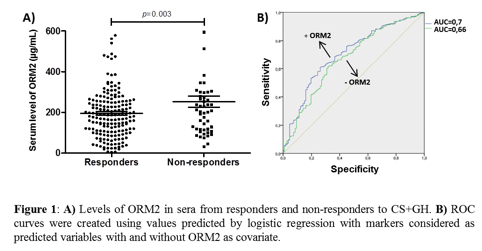Session Information
Date: Monday, November 6, 2017
Title: Osteoarthritis – Clinical Aspects Poster I: Clinical Trials and Interventions
Session Type: ACR Poster Session B
Session Time: 9:00AM-11:00AM
Orosomucoid 2 Serves as Predictor of Therapeutic Response in Osteoarthritis Patients Treated with Chondroitin Sulfate/Glucosamine Hydrochloride
V. Calamia, M. Camacho, I. Rego-PŽrez, L. Gonz‡lez, P. Fern‡ndez-Puente, F. Picchi, M. Herrero, H. Mart’nez, C. Ruiz-Romero, F. J. Blanco.
Background/Purpose:
The present study explored potential protein biomarkers useful to predict the therapeutic response of osteoarthritis (OA) patients treated with pharmaceutical grade Chondroitin sulfate plus glucosamine hydrochloride (CS+GH) or the COX-2 selective nonsteroidal anti-inflammatory drug Celecoxib, in order to optimize therapeutic outcomes in OA.
Methods:
A shotgun proteomic analysis was performed on sera from 80 patients enrolled in the Multicentre Osteoarthritis interVEntion trial with Sysadoa (MOVES), employing the iTRAQ labelling technique (Sciex) followed by LC-MALDI-MS/MS analysis. One of the altered proteins was selected to be validated using commercially available ELISA Kit (Uscn Life Science) in the whole MOVES cohort at baseline. Logistic regression models adjusting for the confounder variables of gender, age, BMI, KL grade, VAS score and WOMAC score at baseline, as well as receiver-operating-characteristics (ROC) curves, were used to analyze the accuracy of the measured protein as predictive biomarker for OA treatment.
Results:
We employed a quantitative proteomic approach to identify differentially expressed proteins between OA responders and non-responders before starting the pharmacological treatment (Chondroitin sulfate/glucosamine hydrochloride or Celecoxib). Serum levels of orosomucoid 2 (ORM2) were measured by ELISA assays in 451 OA patients (n=229 for CS+GH group and n=222 for Celecoxib group). As shown in figure 1A, baseline ORM2 levels were significantly higher in patients who obtained unfavorable outcome (reduction in WOMAC score <20%) after 6 month of treatment with CS+GH (252,2 vs 195,4 ug/mL; n=51 vs 178; p=0,003), while no statistically significant differences were found in the Celecoxib group (data not shown). Both WOMAC and VAS scores at baseline significantly influence patientsÕ response regardless of treatment (p=0,001 and p<0,001 respectively). Notably, if we include baseline ORM2 as covariate, we found a specific interaction between response to CS+GH and baseline ORM2 levels (p=0,012) thus increasing the predictive power of our study (Figure 1B).
Conclusion:
Our results show that ORM2 levels significantly correlate with patientsÕ response to pharmaceutical grade Chondroitin Sulfate/Glucosamine Hydrochloride suggesting the possibility of its use in predictive assays in order to optimize therapeutic outcomes in OA.
To cite this abstract in AMA style:
Calamia V, Camacho M, Rego-Pérez I, González L, Fernández-Puente P, Picchi F, Herrero M, Martinez H, Ruiz-Romero C, Blanco FJ. Orosomucoid 2 Serves As Predictor of Therapeutic Response in Osteoarthritis Patients Treated with Chondroitin Sulfate/Glucosamine Hydrochloride [abstract]. Arthritis Rheumatol. 2017; 69 (suppl 10). https://acrabstracts.org/abstract/orosomucoid-2-serves-as-predictor-of-therapeutic-response-in-osteoarthritis-patients-treated-with-chondroitin-sulfateglucosamine-hydrochloride/. Accessed .« Back to 2017 ACR/ARHP Annual Meeting
ACR Meeting Abstracts - https://acrabstracts.org/abstract/orosomucoid-2-serves-as-predictor-of-therapeutic-response-in-osteoarthritis-patients-treated-with-chondroitin-sulfateglucosamine-hydrochloride/

